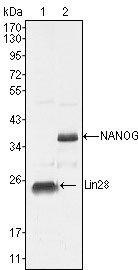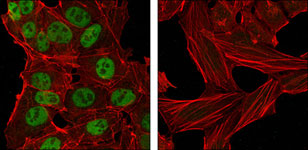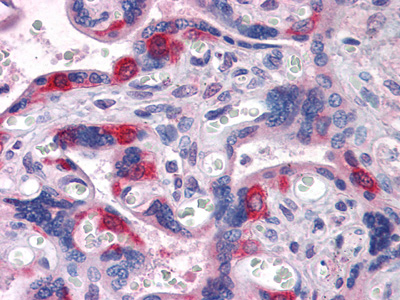NANOG Antibody
Purified Mouse Monoclonal Antibody
- 产品详情
- 实验流程
Application
| WB, ICC, E |
|---|---|
| Primary Accession | Q9H9S0 |
| Reactivity | Human |
| Host | Mouse |
| Clonality | Monoclonal |
| Clone Names | 1E6C4 |
| Isotype | IgG1 |
| Calculated MW | 34620 Da |
| Description | NANOG: Nanog homeobox. Entrez Protein NP_079141. Nanog is a divergent homeodomain protein that directs pluripotency and differentiation of undifferentiated embryonic stem cells. Nanog mRNA is present in pluripotent mouse and human cell lines, and absent from differentiated cells. Human Nanog protein shares 52% overall amino acid identity with the mouse protein and 85% identity in the homeodomain. Human Nanog maps to gene locus 12p13.31, whereas mouse Nanog maps to gene loci 6 F2. Murine embryonic Nanog expression is detected in the inner cell mass of the blastocyst. High levels of human Nanog expression were detected by Northern analysis in the undifferentiated N-Tera embryonal carcinoma cell line. |
| Immunogen | Purified recombinant fragment of NANOG (aa20-166) expressed in E. Coli. |
| Formulation | Ascitic fluid containing 0.03% sodium azide. |
| Gene ID | 79923 |
|---|---|
| Other Names | Homeobox protein NANOG, Homeobox transcription factor Nanog, hNanog, NANOG |
| Dilution | WB~~1/500 - 1/2000 ICC~~N/A E~~N/A |
| Storage | Maintain refrigerated at 2-8°C for up to 6 months. For long term storage store at -20°C in small aliquots to prevent freeze-thaw cycles. |
| Precautions | NANOG Antibody is for research use only and not for use in diagnostic or therapeutic procedures. |
| Name | NANOG |
|---|---|
| Function | Transcription regulator involved in inner cell mass and embryonic stem (ES) cells proliferation and self-renewal. Imposes pluripotency on ES cells and prevents their differentiation towards extraembryonic endoderm and trophectoderm lineages. Blocks bone morphogenetic protein-induced mesoderm differentiation of ES cells by physically interacting with SMAD1 and interfering with the recruitment of coactivators to the active SMAD transcriptional complexes. Acts as a transcriptional activator or repressor. Binds optimally to the DNA consensus sequence 5'-TAAT[GT][GT]-3' or 5'-[CG][GA][CG]C[GC]ATTAN[GC]- 3'. Binds to the POU5F1/OCT4 promoter (PubMed:25825768). Able to autorepress its expression in differentiating (ES) cells: binds to its own promoter following interaction with ZNF281/ZFP281, leading to recruitment of the NuRD complex and subsequent repression of expression. When overexpressed, promotes cells to enter into S phase and proliferation. |
| Cellular Location | Nucleus {ECO:0000255|PROSITE-ProRule:PRU00108, ECO:0000269|PubMed:15983365} |
| Tissue Location | Expressed in testicular carcinoma and derived germ cell tumors (at protein level). Expressed in fetal gonads, ovary and testis. Also expressed in ovary teratocarcinoma cell line and testicular embryonic carcinoma. Not expressed in many somatic organs and oocytes. |
Research Areas
For Research Use Only. Not For Use In Diagnostic Procedures.
Application Protocols
Provided below are standard protocols that you may find useful for product applications.
REFERENCES
1. Genes Cells. 2006 Sep;11(9):1115-23. 2. Mol Biol Cell. 2007 May;18(5):1543-53.
终于等到您。ABCEPTA(百远生物)抗体产品。
点击下方“我要评价 ”按钮提交您的反馈信息,您的反馈和评价是我们最宝贵的财富之一,
我们将在1-3个工作日内处理您的反馈信息。
如有疑问,联系:0512-88856768 tech-china@abcepta.com.























 癌症的基本特征包括细胞增殖、血管生成、迁移、凋亡逃避机制和细胞永生等。找到癌症发生过程中这些通路的关键标记物和对应的抗体用于检测至关重要。
癌症的基本特征包括细胞增殖、血管生成、迁移、凋亡逃避机制和细胞永生等。找到癌症发生过程中这些通路的关键标记物和对应的抗体用于检测至关重要。 为您推荐一个泛素化位点预测神器——泛素化分析工具,可以为您的蛋白的泛素化位点作出预测和评分。
为您推荐一个泛素化位点预测神器——泛素化分析工具,可以为您的蛋白的泛素化位点作出预测和评分。 细胞自噬受体图形绘图工具为你的蛋白的细胞受体结合位点作出预测和评分,识别结合到自噬通路中的蛋白是非常重要的,便于让我们理解自噬在正常生理、病理过程中的作用,如发育、细胞分化、神经退化性疾病、压力条件下、感染和癌症。
细胞自噬受体图形绘图工具为你的蛋白的细胞受体结合位点作出预测和评分,识别结合到自噬通路中的蛋白是非常重要的,便于让我们理解自噬在正常生理、病理过程中的作用,如发育、细胞分化、神经退化性疾病、压力条件下、感染和癌症。








